国际经济学第三次作业
- 格式:docx
- 大小:18.57 KB
- 文档页数:4
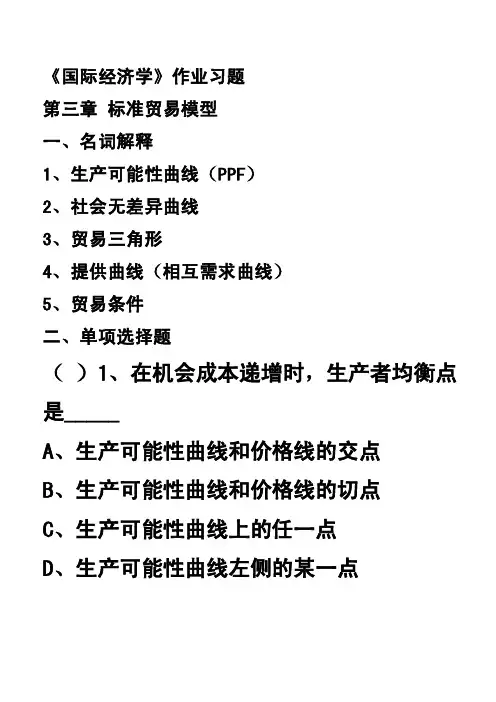
《国际经济学》作业习题第三章标准贸易模型一、名词解释1、生产可能性曲线(PPF)2、社会无差异曲线3、贸易三角形4、提供曲线(相互需求曲线)5、贸易条件二、单项选择题()1、在机会成本递增时,生产者均衡点是_____A、生产可能性曲线和价格线的交点B、生产可能性曲线和价格线的切点C、生产可能性曲线上的任一点D、生产可能性曲线左侧的某一点()2、一国的出口品的价格指数上升,_____A、会导致该国的贸易条件改善B、会导致该国的贸易条件恶化C、不会影响该国的贸易条件D、表明该国出口同样数量的产品,可以换来比过去更少的进口品()3、根据新古典贸易理论,两国可以进行贸易的前提是:_____A、两国的生产可能性曲线形状和位置不同B、两国的社会无差异曲线的形状和位置不同C、两国的资源禀赋不同D、两国封闭经济时的相对商品价格不同三、多项选择题()1、国内封闭经济的均衡点位于_____ A、该国的生产可能性曲线和国内价格线的切点上B、该国的生产可能性曲线和社会无差异曲线的切点上C、该国的社会无差异曲线和国内价格线的切点上D、该国的社会无差异曲线的任一点上E、该国的生产可能性曲线和横轴的交点上()2、当机会成本递增时,生产可能性曲线_____A、是一条向右下方倾斜的直线B、是一条向右下方倾斜并且凹向原点的曲线C、是一条向右下方倾斜并且凸向原点的曲线D、上面各点的斜率是不断变化的E、上面各点的斜率是相同的()3、一国在国际贸易以前和以后的社会无差异曲线不会相交,如果_____A、国际贸易不影响收入分配状况B、国际贸易会影响收入分配状况C、一国居民的偏好改变了D、一国居民的偏好不变()4、两国提供曲线的交点所对应的相对商品价格, _____A、使得一国的出口量等于另一国的进口量B、不能保证一国的出口量等于另一国的进口量C、一定是均衡的相对商品价格D、不一定时均衡的相对商品价格()5、当一种产品的世界市场价格高于一国封闭经济时的均衡价格水平时,_____A、该国可能成为该产品的出口国B、该国可能成为该产品的进口国C、该产品是该国具有比较优势的产品D、该产品是该国具有比较劣势的产品()6、贸易条件恶化是指_____A、出口价格指数不变,进口价格指数上升B、进口价格指数不变,出口价格指数上升C、出口价格指数下降,进口价格指数上升D、进口价格指数下降,出口价格指数上升E、进出口价格指数同时上升四、填空题1、一国的提供曲线凸向该国具有比较____________的商品所在的坐标轴。
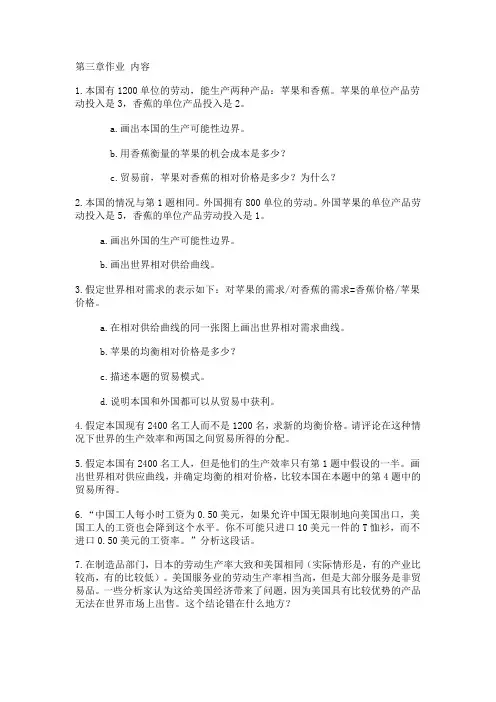
第三章作业内容1.本国有1200单位的劳动,能生产两种产品:苹果和香蕉。
苹果的单位产品劳动投入是3,香蕉的单位产品投入是2。
a.画出本国的生产可能性边界。
b.用香蕉衡量的苹果的机会成本是多少?c.贸易前,苹果对香蕉的相对价格是多少?为什么?2.本国的情况与第1题相同。
外国拥有800单位的劳动。
外国苹果的单位产品劳动投入是5,香蕉的单位产品劳动投入是1。
a.画出外国的生产可能性边界。
b.画出世界相对供给曲线。
3.假定世界相对需求的表示如下:对苹果的需求/对香蕉的需求=香蕉价格/苹果价格。
a.在相对供给曲线的同一张图上画出世界相对需求曲线。
b.苹果的均衡相对价格是多少?c.描述本题的贸易模式。
d.说明本国和外国都可以从贸易中获利。
4.假定本国现有2400名工人而不是1200名,求新的均衡价格。
请评论在这种情况下世界的生产效率和两国之间贸易所得的分配。
5.假定本国有2400名工人,但是他们的生产效率只有第1题中假设的一半。
画出世界相对供应曲线,并确定均衡的相对价格,比较本国在本题中的第4题中的贸易所得。
6.“中国工人每小时工资为0.50美元,如果允许中国无限制地向美国出口,美国工人的工资也会降到这个水平。
你不可能只进口10美元一件的T恤衫,而不进口0.50美元的工资率。
”分析这段话。
7.在制造品部门,日本的劳动生产率大致和美国相同(实际情形是,有的产业比较高,有的比较低)。
美国服务业的劳动生产率相当高,但是大部分服务是非贸易品。
一些分析家认为这给美国经济带来了问题,因为美国具有比较优势的产品无法在世界市场上出售。
这个结论错在什么地方?8.访问过日本的人都知道日本的物价很高,而日本工人的工资和他们的美国同行差不多,因此他们收入的购买力只有美国的1/3,扩展第7题的讨论来解释这个现象。
(提示:考虑工资率和非贸易品的价格。
)9.许多产品部能进行贸易的事实对贸易所得的大小会产生什么影响?10.我们重点讨论了只包含了两个国家的例子。
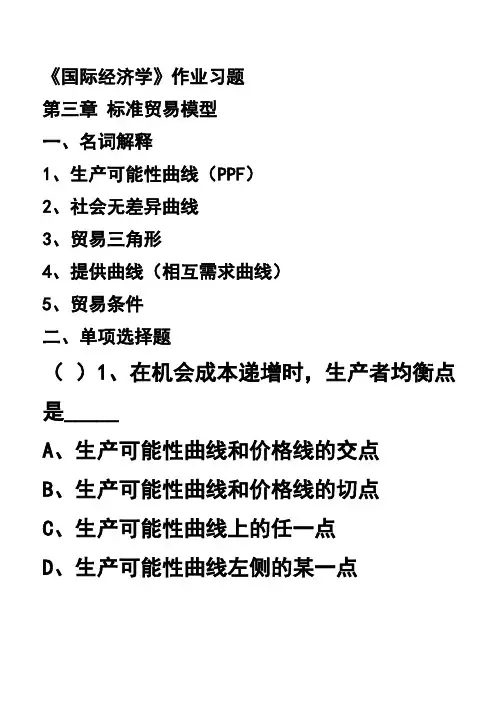
《国际经济学》作业习题第三章标准贸易模型一、名词解释1、生产可能性曲线(PPF)2、社会无差异曲线3、贸易三角形4、提供曲线(相互需求曲线)5、贸易条件二、单项选择题()1、在机会成本递增时,生产者均衡点是_____A、生产可能性曲线和价格线的交点B、生产可能性曲线和价格线的切点C、生产可能性曲线上的任一点D、生产可能性曲线左侧的某一点()2、一国的出口品的价格指数上升,_____A、会导致该国的贸易条件改善B、会导致该国的贸易条件恶化C、不会影响该国的贸易条件D、表明该国出口同样数量的产品,可以换来比过去更少的进口品()3、根据新古典贸易理论,两国可以进行贸易的前提是:_____A、两国的生产可能性曲线形状和位置不同B、两国的社会无差异曲线的形状和位置不同C、两国的资源禀赋不同D、两国封闭经济时的相对商品价格不同三、多项选择题()1、国内封闭经济的均衡点位于_____ A、该国的生产可能性曲线和国内价格线的切点上B、该国的生产可能性曲线和社会无差异曲线的切点上C、该国的社会无差异曲线和国内价格线的切点上D、该国的社会无差异曲线的任一点上E、该国的生产可能性曲线和横轴的交点上()2、当机会成本递增时,生产可能性曲线_____A、是一条向右下方倾斜的直线B、是一条向右下方倾斜并且凹向原点的曲线C、是一条向右下方倾斜并且凸向原点的曲线D、上面各点的斜率是不断变化的E、上面各点的斜率是相同的()3、一国在国际贸易以前和以后的社会无差异曲线不会相交,如果_____A、国际贸易不影响收入分配状况B、国际贸易会影响收入分配状况C、一国居民的偏好改变了D、一国居民的偏好不变()4、两国提供曲线的交点所对应的相对商品价格, _____A、使得一国的出口量等于另一国的进口量B、不能保证一国的出口量等于另一国的进口量C、一定是均衡的相对商品价格D、不一定时均衡的相对商品价格()5、当一种产品的世界市场价格高于一国封闭经济时的均衡价格水平时,_____A、该国可能成为该产品的出口国B、该国可能成为该产品的进口国C、该产品是该国具有比较优势的产品D、该产品是该国具有比较劣势的产品()6、贸易条件恶化是指_____A、出口价格指数不变,进口价格指数上升B、进口价格指数不变,出口价格指数上升C、出口价格指数下降,进口价格指数上升D、进口价格指数下降,出口价格指数上升E、进出口价格指数同时上升四、填空题1、一国的提供曲线凸向该国具有比较____________的商品所在的坐标轴。
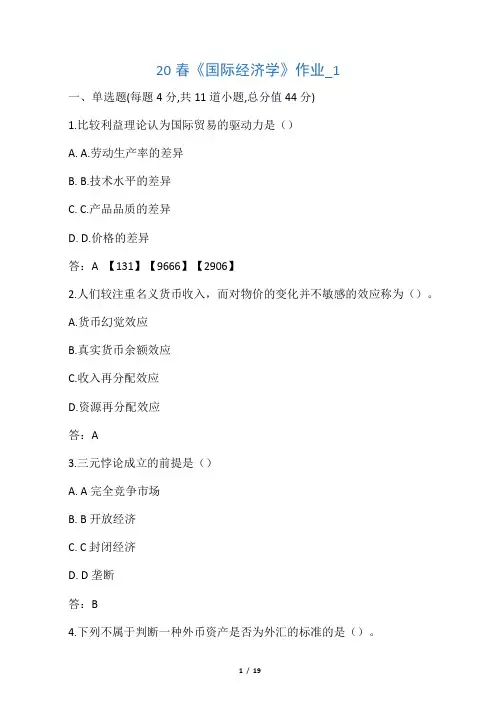
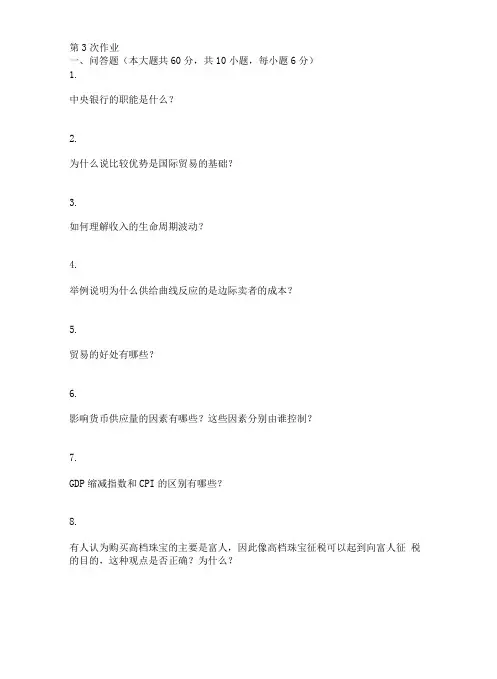
第3次作业一、问答题(本大题共60分,共10小题,每小题6分)1.中央银行的职能是什么?2.为什么说比较优势是国际贸易的基础?3.如何理解收入的生命周期波动?4.举例说明为什么供给曲线反应的是边际卖者的成本?5.贸易的好处有哪些?6.影响货币供应量的因素有哪些?这些因素分别由谁控制?7.GDP缩减指数和CPI的区别有哪些?8.有人认为购买高档珠宝的主要是富人,因此像高档珠宝征税可以起到向富人征税的目的,这种观点是否正确?为什么?表1中所示的是某个孤岛上面粉的需求表。
假如生产面粉的边际成本等于0, 请分析,如果孤岛上有一个唯一的垄断企业提供这些面粉,垄断企业的产量为多少?如果孤岛上有两个寡头垄断的卖者,那么他们各自将选择生产多少产量?最终寡头垄断企业的利润是多少产量(吨)价格(美元)总收益(美元)010019927143 4.513.5441653156 2.414.410.公共场所严禁吸烟是否是有效率的规定?为什么要做出这种规定?二、填空题(本大题共40分,共10小题,每小题4分)1.指同一单位商品不能同时被不同的人使用,也就是说一个人使用该产品减少了其他人对该物品的使用。
2.指资产转化为交换媒介的难易程度。
3.经济学最重要的假设前提是________ o4.当的价格上限发生时,经济中会出现短缺。
GDP缩减指数二xlOO%6.在现行的价格下,生产者愿意出售的产品数量大于消费者愿意购买的数量,这时发生了。
7.如果一个国家生产某种产品的较低,那么这个国家在该产品的生产上具有比较优势。
8.生活在贫困线以下的人曰的比例。
9.二买者的评价-卖者的成本。
10.投入品越特殊,某种商品的供给弹性。
答案:一、问答题(60分,共10题,每小题6分)1.参考答案:第一,控制货币供应量。
第二,监督和管理商业银行的行为。
解题方案:参考答案:根据比较优势原理,即使一个国家在所有商品生产从效率方面较另一个国家都具有劣势,但只要劣势程度不同,也可以在劣势相对较小的产品生产上具有比较优势,而处于优势的国家则可以在优势较大的产品生产上具有比较优势。
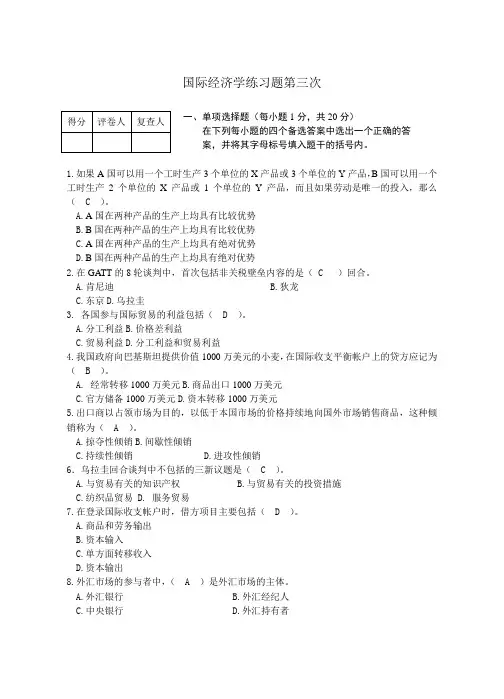
国际经济学练习题第三次1.如果A 国可以用一个工时生产3个单位的X 产品或3个单位的Y 产品,B 国可以用一个工时生产2个单位的X 产品或1个单位的Y 产品,而且如果劳动是唯一的投入,那么( C )。
A.A 国在两种产品的生产上均具有比较优势B.B 国在两种产品的生产上均具有比较优势C.A 国在两种产品的生产上均具有绝对优势D.B 国在两种产品的生产上均具有绝对优势2.在GA TT 的8轮谈判中,首次包括非关税壁垒内容的是( C )回合。
A.肯尼迪B.狄龙C.东京D.乌拉圭3. 各国参与国际贸易的利益包括( D )。
A.分工利益B.价格差利益C.贸易利益D.分工利益和贸易利益4.我国政府向巴基斯坦提供价值1000万美元的小麦,在国际收支平衡帐户上的贷方应记为( B )。
A. 经常转移1000万美元B.商品出口1000万美元C.官方储备1000万美元D.资本转移1000万美元5.出口商以占领市场为目的,以低于本国市场的价格持续地向国外市场销售商品,这种倾销称为( A )。
A.掠夺性倾销B.间歇性倾销C.持续性倾销D.进攻性倾销6.乌拉圭回合谈判中不包括的三新议题是( C )。
A.与贸易有关的知识产权B.与贸易有关的投资措施C.纺织品贸易D. 服务贸易7.在登录国际收支帐户时,借方项目主要包括( D )。
A.商品和劳务输出B.资本输入C.单方面转移收入D.资本输出8.外汇市场的参与者中,( A )是外汇市场的主体。
A.外汇银行B.外汇经纪人C.中央银行D.外汇持有者一、单项选择题(每小题1分,共20分) 在下列每小题的四个备选答案中选出一个正确的答 案,并将其字母标号填入题干的括号内。
9.在布雷顿森林体系下,不属于国际货币基金组织基本职能的是( B )。
A.维持固定汇率体制B.通货膨胀问题C.协助建立多边支付体系D.监督成员国的国际收支10.如果人民币与美元的即期汇率为$1=¥6.00,三个月的远期汇率为$1=¥5.95,这表示( D )。

Chapter 3 Labor Productivity and ComparativeAdvantage —The Ricardian ModelMultiple Choice Questions1. Countries trade with each other because they are _______ and because of ______.(a) different, costs(b) similar, scale economies(c) different, scale economies(d) similar, costs(e) None of the above.Answer: C2. Trade between two countries can benefit both countries if(a) each country exports that good in which it has a comparative advantage.(b) each country enjoys superior terms of trade.(c) each country has a more elastic demand for the imported goods.(d) each country has a more elastic supply for the supplied goods.(e) Both (c) and (d).Answer: A3. The Ricardian theory of comparative advantage states that a country has a comparative advantagein widgets if(a) output per worker of widgets is higher in that country.(b) that country’s exchange rate is low.(c) wage rates in that country are high.(d) the output per worker of widgets as compared to the output of some other product is higher inthat country.(e) Both (b) and (c).Answer: D4. In order to know whether a country has a comparative advantage in the production of one particularproduct we need information on at least ____unit labor requirements(a) one(b) two(c) three(d) four(e) fiveAnswer: D5. A country engaging in trade according to the principles of comparative advantage gains from tradebecause it(a) is producing exports indirectly more efficiently than it could alternatively.(b) is producing imports indirectly more efficiently than it could domestically.(c) is producing exports using fewer labor units.(d) is producing imports indirectly using fewer labor units.(e) None of the above.Answer: B6. Given the following information:Unit Labor RequirementsCloth WidgetsHome1020Foreign6030(a) Neither country has a comparative advantage.(b) Home has a comparative advantage in cloth.(c) Foreign has a comparative advantage in cloth.(d) Home has a comparative advantage in widgets.(e) Home has a comparative advantage in both products.Answer: B7. If it is ascertained that Foreign uses prison-slave labor to produce its exports, then home should(a) export cloth.(b) export widgets.(c) export both and import nothing.(d) export and import nothing.(e) All of the above.Answer: A8. If the Home economy suffered a meltdown, and the Unit Labor Requirements in each of the productsquadrupled (that is, doubled to 30 for cloth and 60 for widgets) then home should(a) export cloth.(b) export widgets.(c) export both and import nothing.(d) export and import nothing.(e) All of the above.Answer: A9. If wages were to double in Home, then Home should:(a) export cloth.(b) export widgets.(c) export both and import nothing.(d) export and import nothing.(e) All of the above.Answer: A10. If the world equilibrium price of widgets were 4 Cloths, then(a) both countries could benefit from trade with each other.(b) neither country could benefit from trade with each other.第 19 页(c) each country will want to export the good in which it enjoys comparative advantage.(d) neither country will want to export the good in which it enjoys comparative advantage.(e) both countries will want to specialize in cloth.Answer: A11. Given the following information:Number of Units Produced by one Unit of LaborCloth WidgetsHome1020Foreign6030(a) Neither country has a comparative advantage.(b) Home has a comparative advantage in cloth.(c) Foreign has a comparative advantage in cloth.(d) Foreign has a comparative advantage in widgets.(e) Home has a comparative advantage in both products.Answer: C12. The opportunity cost of cloth in terms of widgets in Foreign is if it is ascertained that Foreignuses prison-slave labor to produce its exports, then home should(a) export cloth.(b) export widgets.(c) export both and import nothing.(d) export and import nothing.(e) All of the above.Answer: B13. If wages were to double in Home, then Home should(a) export cloth.(b) export widgets.(c) export both and import nothing.(d) export and import nothing.(e) All of the above.Answer: B14. If the world equilibrium price of widgets were 4 Cloths, then(a) both countries could benefit from trade with each other.(b) neither country could benefit from trade with each other.(c) each country will want to export the good in which it enjoys comparative advantage.(d) neither country will want to export the good in which it enjoys comparative advantage.(e) both countries will want to specialize in cloth.Answer: A15. If the world equilibrium price of widgets were 40 cloths, then(a) both countries could benefit from trade with each other.(b) neither country could benefit from trade with each other.(c) each country will want to export the good in which it enjoys comparative advantage.(d) neither country will want to export the good in which it enjoys comparative advantage.(e) both countries will want to specialize in cloth.Answer: A16. In a two product two country world, international trade can lead to increases in(a) consumer welfare only if output of both products is increased.(b) output of both products and consumer welfare in both countries.(c) total production of both products but not consumer welfare in both countries.(d) consumer welfare in both countries but not total production of both products.(e) None of the aboveAnswer: B17. As a result of trade, specialization in the Ricardian model tends to be(a) complete with constant costs and with increasing costs.(b) complete with constant costs and incomplete with increasing costs.(c) incomplete with constant costs and complete with increasing costs.(d) incomplete with constant costs and incomplete with increasing costs.(e) None of the above.Answer: B18. As a result of trade between two countries which are of completely different economic sizes,specialization in the Ricardian 2X2 model tends to be(a) incomplete in both countries(b) complete in both countries(c) complete in the small country but incomplete in the large country(d) complete in the large country but incomplete in the small country(e) None of the aboveAnswer: C19. A nation engaging in trade according to the Ricardian model will find its consumption bundle(a) inside its production possibilities frontier.(b) on its production possibilities frontier.(c) outside its production possibilities frontier.(d) inside its trade-partner’s production possibilities frontier.(e) on its trade-partner’s production possibilities frontier.Answer: C第 21 页20. In the Ricardian model, if a country’s trade is restricted, this will cause all except which?(a) Limit specialization and the division of labor.(b) Reduce the volume of trade and the gains from trade(c) Cause nations to produce inside their production possibilities curves(d) May result in a country producing some of the product of its comparative disadvantage(e) None of the above.Answer: C21. If a very small country trades with a very large country according to the Ricardian model, then(a) the small country will suffer a decrease in economic welfare.(b) the large country will suffer a decrease in economic welfare.(c) the small country only will enjoy gains from trade.(d) the large country will enjoy gains from trade.(e) None of the above.Answer: C22. If the world terms of trade for a country are somewhere between the domestic cost ratio of H andthat of F, then(a) country H but not country F will gain from trade.(b) country H and country F will both gain from trade.(c) neither country H nor F will gain from trade.(d) only the country whose government subsidizes its exports will gain.(e) None of the above.Answer: B23. If the world terms of trade equal those of country F, then(a) country H but not country F will gain from trade.(b) country H and country F will both gain from trade.(c) neither country H nor F will gain from trade.(d) only the country whose government subsidizes its exports will gain.(e) None of the above.Answer: A24. If the world terms of trade equal those of country, F then(a) country H but not country F will gain from trade.(b) country H and country F will both gain from trade.(c) neither country H nor F will gain from trade.(d) only the country whose government subsidizes its exports will gain.(e) None of the above.Answer: E25. If a production possibilities frontier is bowed out (concave to the origin), then productionoccurs under conditions of(a) constant opportunity costs.(b) increasing opportunity costs.(c) decreasing opportunity costs.(d) infinite opportunity costs.(e) None of the above.Answer: B26. If the production possibilities frontier of one the trade partners (“Country A”) is bowed out(concave to the origin), then increased specialization in production by that country will(a) Increase the economic welfare of both countries.(b) Increase the economic welfare of only Country A.(c) Decrease the economic welfare of Country A.(d) Decrease the economic welfare of Country B.(e) None of the above.Answer: A27. If two countries have identical production possibility frontiers, then trade between them is not likelyif(a) their supply curves are identical.(b) their cost functions are identical.(c) their demand conditions identical.(d) their incomes are identical.(e) None of the above.Answer: E28. If two countries have identical production possibility frontiers, then trade between them is not likelyif(a) their supply curves are identical.(b) their cost functions are identical.(c) their demand functions differ.(d) their incomes are identical.(e) None of the above.Answer: C29. The earliest statement of the principle of comparative advantage is associated with(a) David Hume.(b) David Ricardo.(c) Adam Smith.(d) Eli Heckscher.(e) Bertil Ohlin.Answer: B第 23 页30. If one country’s wage level is very high relative to the other’s (the relative wage exceedingthe relative productivity ratios), then if they both use the same currency(a) neither country has a comparative advantage.(b) only the low wage country has a comparative advantage.(c) only the high wage country has a comparative advantage.(d) consumers will still find trade worth while from their perspective.(e) None of the above.Answer: E31. If one country’s wage level is very high relative to the other’s (the relative wage exceedingthe relative productivity ratios), then(a) it is not possible that producers in each will find export markets profitable.(b) it is not possible that consumers in both countries will enhance their respective welfaresthrough imports.(c) it is not possible that both countries will find gains from trade.(d) it is possible that both will enjoy the conventional gains from trade.(e) None of the above.Answer: D32. If one country’s wage level is very high relative to the other’s (the relative wage exceedingthe relative productivity ratios) then it is probable that(a) free trade will improve both countries’ welfare(b) free trade will result in no trade taking place(c) free trade will result in each country exporting the good in which it enjoys comparativeadvantage(d) free trade will result in each country exporting the good in which it suffers the greatestcomparative disadvantage.(e) None of the above.Answer: B33. The Ricardian 2X2 model is based on all of the following except only two nations and two products.(a) no diminishing returns.(b) labor is the only factor of production.(c) product quality varies among nations.(d) None of the above.Answer: D34. Ricardo’s original theory of comparative advantage seemed of limited real-world value because itwas founded on the labor theory of value.(a) capital theory of value.(b) land theory of value.(c) entrepreneur theory of value.(d) None of the above.Answer: A35. According to Ricardo, a country will have a comparative advantage in the product in which its(a) labor productivity is relatively low.(b) labor productivity is relatively high.(c) labor mobility is relatively low.(d) labor mobility is relatively high.(e) None of the above.Answer: B36. In a two-country, two-product world, the statement “Germany enjoys a comparative advantage overFrance in autos relative to ships” is equivalent to(a) France having a comparative advantage over Germany in ships.(b) France having a comparative disadvantage compared to Germany in autos and ships.(c) Germany having a comparative advantage over France in autos and ships.(d) France having no comparative advantage over Germany.(e) None of the above.Answer: A37. Assume that labor is the only factor of production and that wages in the United States equal$20 per hour while wages in Japan are $10 per hour. Production costs would be lower in the United States as compared to Japan if(a) U.S. labor productivity equaled 40 units per hour and Japan’s 15 units per hour.(b) U.S. productivity equaled 30 units per hour whereas Japan’s was 20.(c) U.S. labor productivity equaled 20 and Japan’s 30.(d) U.S. labor productivity equaled 15 and Japan’s 25 units per hour.(e) None of the above.Answer: A38. If the United States’s production possibility frontier was flatter to the widget axis, whereasGermany’s was flatter to the butter axis, we know that(a) the United States has no comparative advantage(b) Germany has a comparative advantage in butter.(c) the U.S. has a comparative advantage in butter.(d) Not enough information is given.(e) None of the above.Answer: B39. Suppose the Uni ted State’s production possibility frontier was flatter to the widget axis,whereas Germany’s was flatter to the butter axis. We now learn that the German mark sharplydepreciates against the U.S. dollar. We now know that(a) the United States has no comparative advantage(b) Germany has a comparative advantage in butter.(c) the United States has a comparative advantage in butter.(d) Not enough information is given.(e) None of the above.Answer: B第 25 页40. Suppose the United State’s production possibility fr ontier was flatter to the widget axis,whereas Germany’s was flatter to the butter axis. We now learn that the German wage doubles, but U.S. wages do not change at all. We now know that(a) the United States has no comparative advantage.(b) Germany has a comparative advantage in butter.(c) the United States has a comparative advantage in butter.(d) Not enough information is given.(e) None of the above.Answer: B41. Which of the following statements is true(a) Free trade is beneficial only if your country is strong enough to stand up to foreigncompetition(b) Free trade is beneficial only if your competitor does not pay unreasonably low wages(c) Free trade is beneficial only if both countries have access to the same technology.(d) All of the above(e) None of the aboveAnswer: E42. The Gains from Trade associated with the principle of Comparative Advantage depends on(a) The trade partners must differ in technology or tastes.(b) There can be no more goods traded than the number of trade partners.(c) There may be no more trade partners than goods traded.(d) All of the above(e) None of the aboveAnswer: A43. If transportation costs are especially high for Widgets in a Ricardian 2X2 model in which CountryA enjoys a comparative advantage, then(a) Country B must also enjoy a comparative advantage in Widgets(b) Country B may end up exporting Widgets(c) Country A may switch to having a comparative advantage in the other good.(d) All of the above(e) None of the aboveAnswer E44. Mahatma Ghandi exhorted his followers in India to promote economic welfare by decreasing imports.This approach(a) Makes no sense(b) Makes no economic sense(c) Is consistent with the the Ricardian model of comparative advantage.(d) Is not consistent with the Ricardian model of comparative advantage.(e) None of the aboveAnswer: D45. The Country of Rhozundia is blessed with rich copper deposits. The cost of Copper produced(relative to the cost of Widgets produced) is therefore very low. From this information we knowthat(a) Rhozundia has a comparative advantage in Copper(b) Rhozundia should export Copper and import Widgets(c) Rhozundia should export Widgets and export Copper(d) Both (a) and (b) are true(e) None of the above.Answer: E46. We know that in antiquity, China exported silk because no-one in any other country knew how toproduce this product. From this information we learn that(a) China enjoyed a comparative advantage in Silk(b) China enjoyed an absolute advantage, but not a comparative advantage in silk.(c) No comparative advantage exists because technology was not diffused(d) China should have exported silk even though it had no comparative advantage(e) None of the above.Answer: A47. If two countries engage in Free Trade following the principles of comparative advantage, then(a) Neither relative prices nor relative marginal costs (marginal rates of transformation—MRTs)in one country will equal those in the other country.(b) Both relative prices and MRTs will become equal in both countries(c) Relative prices but not MRTs will become equal in both countries(d) MRTs but not relative prices will become equal in both countries(e) None of the above.Answer: C48. Let us define the real wage as the purchasing power of one hour of labor. In the Ricardian 2X2 model,if two countries under autarky engage in trade then(a) The real wage will not be affected since this is a financial variable.(b) The real wage will increase only if a country attains full specialization(c) The real wage will increase in one country only if it decreases in the other(d) The real wage will rise in both countries.(e) None of the above.Answer: D49. If two countries in Autarky (not engaged in international trade) begin trading with other in amanner consistent with the Ricardian model of comparative advantage, then(a) The amount of labor required to produce one unit of imports will decrease in both countries.(b) The amount of labor required to produce one unit of both products will decrease in bothcountries.(c) The amount of labor required to produce one unit of imports will decrease only in therelatively labor abundant country(d) The amount of labor required to produce one unit of imports will decrease only in therelatively capital abundant country.(e) None of the above.Answer: A第 27 页Essay Questions1. Many countries in Sub-Saharan Africa have very low labor productivities in many sectors, inmanufacturing and agriculture. They often despair of even trying to attempt to build theirindustries unless it is done in an autarkic context, behind protectionist walls because they do not believe they can compete with more productive industries abroad. Discuss this issue in the context of the Ricardian model of comparative advantage.Answer: The Ricardian model of comparative advantage argues that every country must have a comparative advantage in some product (assuming there are more products than countries).However, the Ricardian model is not a growth model, and cannot be used to identifygrowth nodes or linkages.2. In 1975, wage levels in South Korea were roughly 5% of those in the United States. It is obviousthat if the United States had allowed Korean goods to be freely imported into the United States at that time, this would have caused devastation to the standard of living in the United States,because no producer in this country could possibly compete with such low wages. Discuss thisassertion in the context of the Ricardian model of comparative advantage.Answer: Regardless of relative wage levels, the United States would be able to provide its populace with a higher standard of living than would be possible without trade. Also,low wages tend to be associated with low productivities.3. The evidence cited in the chapter using the examples of the East Asia New IndustrializingCountries suggests that as international productivities converge, so do international wage levels.Why do you suppose this happened for the East Asian NICs? In light of your answer, what do you think is likely to happen to the relative wages (relative to those in the United States) of China in the coming decade? Explain your reasoning.Answer: Following the logic of the Ricardian model of comparative advantage, the East Asian countries played to their respective comparative advantages. This allowed the worlddemand to provide excess demands for their relatively abundant labor, which in turntended to raise these wages. If China follows the same pattern, their wages levelsshould also be expected over time to converge to those in their industrialized countrymarkets.4. When we examine the 2 Good 2 Country version of the Ricardian model of comparative advantage, wenote that comparative advantage is totally determined by physical productivity ratios. Changes in wage rates in either country cannot affect these physically determined comparative advantages, and hence cannot affect, which product will be exported by which country. However, when more than2 goods are added to the model (still with 2 countries), changes in wage rates in one or the othercountry can in fact determine which good or goods each of the countries will export. How can you explain this anomaly?Answer: This is not really an anomaly. As long as only two goods exist, then as long as trade takes place, each country must have a comparative advantage in one of them (or none).However, if there are more goods than countries, then the physical productivitydefinition of comparative advantage becomes ambiguous. Changes in relative wage rateswill shift the international competitiveness along t he “chain of comparativeadvantage.”5. An examination of the Ricardian model of comparative advantage yields the clear result that tradeis (potentially) beneficial for each of the two trading partners since it allows for an expanded consumption choice for each. However, for the world as a whole the expansion of production of one product must involve a decrease in the availability of the other, so that it is not clear thattrade is better for the world as a whole as compared to an initial situation of non-trade (butefficient production in each country). Are there in fact gains from trade for the world as a whole?Explain.Answer: If we were to combine the production possibility frontiers of the two countries to create a single world production possibility frontier, then it is true that any changein production points (from autarky to specialization with trade) would involve atradeoff of one good for another from the world’s perspective. In other words, the newsolution cannot possibly involve the production of more of both goods. However, since weknow that each country is better off at the new solution, it must be true that theoriginal points were not on the trade contract curve between the two countries, and itwas in fact possible to make some people better off without making others worse off, sothat the new solution does indeed represent a welfare improvement from the world’sperspective.6. It is generally claimed that a movement from autarky to free trade consistent with Ricardiancomparative advantage increases the economic welfare of each of the trade partners. However, itmay be demonstrated that under certain circumstances, not everyone in each country is made better off. Illustrate such a case.Answers: (a) If inter-generational, or economic growth considerations are taken into account, then a country may end up specializing in a good that has no or few growth linkageswith the rest of the economy (e.g. an “enclave” sector).(b) If some of the residents of a country have tastes biased toward their exportable,then they may suffer due to the trade-affected increase in the market price of theexportable good.7. It is generally claimed that state trading, or centrally controlled trading will tend to reach alower economic welfare than would be reached by allowing market forces to determine trade flowdirections and terms of trade. Illustrate a counter-example to this proposition.Answer: In general, if we begin with any suboptimal distortion, the theory of the second best tells us that an additional “distortion” may move a country in the correct directionof a welfare improvement. For example, If a country has an overvalued exchange rate(that is, its currency is overpriced in the foreign exchange markets), it is possiblethat it will find itself in a n autarkic equilibrium (that is, it might “overpriceitself out of the international market”). In such a case it is easy to demonstrate thatif the government exports the goods in which the country enjoys comparative advantage,and imports the other (bypas sing market prices and mechanisms), the country’s economicwelfare will improve.8. The Ricardian proposition that international trade will benefit any country (“gains from trade”)as long as the world terms of trade do not equal its autarkic relative prices is a straightforward and powerful concept. Nevertheless, it is impossible to demonstrate empirically. Why?Answer: This is because there is no way of knowing exactly what are, or would have been, the autarky MRTs or MRSs. This is because there is no single example in the world ofa country that is totally unengaged in international trade.第 29 页Quantitative/Graphing Problems1. Given the following information:Unit Labor RequirementsCloth WidgetsHome100200Foreign6030What is the opportunity cost of Cloth in terms of Widgets in Foreign?Answer: One half a widget.2. Given the following information:Unit Labor RequirementsCloth WidgetsHome100200Foreign6030If these two countries trade these two goods in the context of the Ricardian model of comparative advantage, then what is the lower limit of the world equilibrium price of widgets?Answer: 2 Cloths.3. Given the following information:Unit Labor RequirementsCloth WidgetsHome10020s0Foreign6030If these two countries trade these two goods with each other in according to the Ricardian model of comparative advantage, what is the lower limit for the price of cloth?Answer: One half a widget.4. Given the following information:Unit Produced by One Worker/HourCloth WidgetsHome100200Foreign6030What is the opportunity cost of cloth in terms of Widgets in Foreign?Answer: 2 widgets.5. Given the following information:Unit Produced by One Worker/HourCloth WidgetsHome100200Foreign6030If these two countries trade these two goods with each other in the following the Ricardian model of comparative advantage, then what is the lower limit for the world equilibrium price of cloth?Answer: 2 widgets.6. Given the following information:One Labor-Hour of Production:U.S.CroatiaSoy30020Toys10020(a) What is the marginal cost of a toy in each country?Answer: 3 units of Soy in the U.S., and 1 Soy unit in Croatia.(b) How might you demonstrate (quantitatively) that a country with absolute productivity advantagein a product may find that its production is more costly than in the other (unproductive)country?Answer: The U.S. have absolute productivity advantage in toys. Nevertheless, toys are three times more costly than they are in Croatia.(c) Demonstrate the fact that trade produces imports (indirectly) cheaper, even in the relativelyunproductive country.Answer: In Croatia, one unit of wheat will cost one toy. However, if the terms of trade fall between the two autarkic price ratios (a condition necessary for both countries to enjoygains from trade), say at 2 Soy units per toy, then Croatia will gain each Soy unit withless ofa sacrifice of toy production.第 31 页。
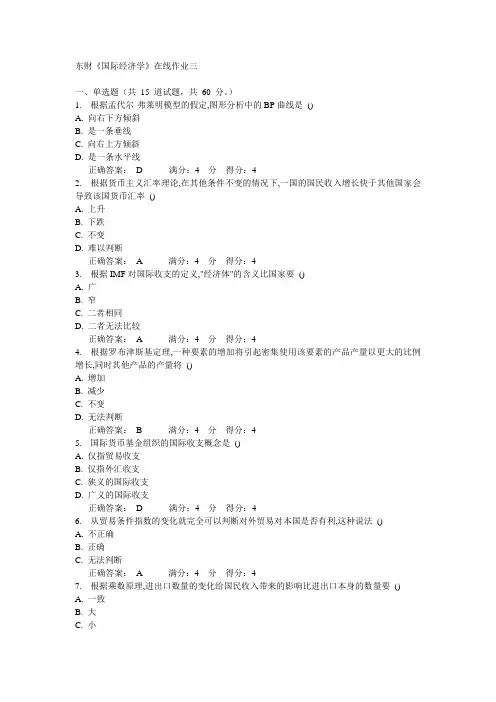
东财《国际经济学》在线作业三
一、单选题(共15 道试题,共60 分。
)
1. 根据孟代尔-弗莱明模型的假定,图形分析中的BP曲线是()
A. 向右下方倾斜
B. 是一条垂线
C. 向右上方倾斜
D. 是一条水平线
正确答案:D 满分:4 分得分:4
2. 根据货币主义汇率理论,在其他条件不变的情况下,一国的国民收入增长快于其他国家会导致该国货币汇率()
A. 上升
B. 下跌
C. 不变
D. 难以判断
正确答案:A 满分:4 分得分:4
3. 根据IMF对国际收支的定义,"经济体"的含义比国家要()
A. 广
B. 窄
C. 二者相同
D. 二者无法比较
正确答案:A 满分:4 分得分:4
4. 根据罗布津斯基定理,一种要素的增加将引起密集使用该要素的产品产量以更大的比例增长,同时其他产品的产量将()
A. 增加
B. 减少
C. 不变
D. 无法判断
正确答案:B 满分:4 分得分:4
5. 国际货币基金组织的国际收支概念是()
A. 仅指贸易收支
B. 仅指外汇收支
C. 狭义的国际收支
D. 广义的国际收支
正确答案:D 满分:4 分得分:4
6. 从贸易条件指数的变化就完全可以判断对外贸易对本国是否有利,这种说法()
A. 不正确
B. 正确
C. 无法判断
正确答案:A 满分:4 分得分:4
7. 根据乘数原理,进出口数量的变化给国民收入带来的影响比进出口本身的数量要()
A. 一致
B. 大
C. 小。
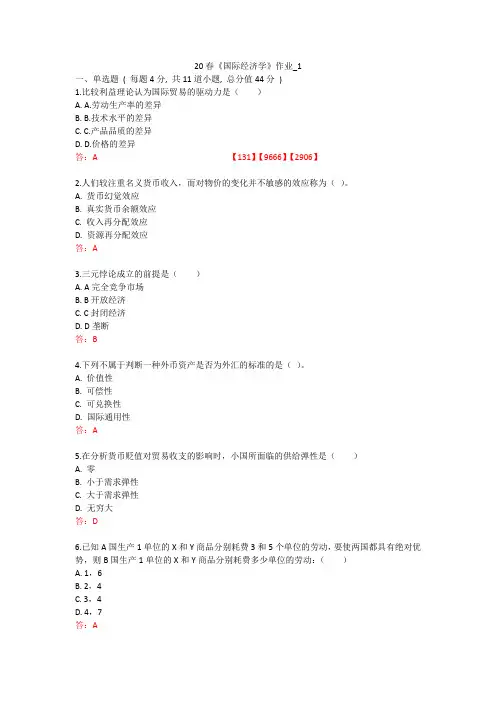
20春《国际经济学》作业_1一、单选题( 每题4分, 共11道小题, 总分值44分)1.比较利益理论认为国际贸易的驱动力是()A. A.劳动生产率的差异B. B.技术水平的差异C. C.产品品质的差异D. D.价格的差异答:A 【131】【9666】【2906】2.人们较注重名义货币收入,而对物价的变化并不敏感的效应称为()。
A. 货币幻觉效应B. 真实货币余额效应C. 收入再分配效应D. 资源再分配效应答:A3.三元悖论成立的前提是()A. A完全竞争市场B. B开放经济C. C封闭经济D. D垄断答:B4.下列不属于判断一种外币资产是否为外汇的标准的是()。
A. 价值性B. 可偿性C. 可兑换性D. 国际通用性答:A5.在分析货币贬值对贸易收支的影响时,小国所面临的供给弹性是()A. 零B. 小于需求弹性C. 大于需求弹性D. 无穷大答:D6.已知A国生产1单位的X和Y商品分别耗费3和5个单位的劳动,要使两国都具有绝对优势,则B国生产1单位的X和Y商品分别耗费多少单位的劳动:()A. 1,6B. 2,4C. 3,4D. 4,7答:A7.在马歇尔—勒纳条件中,进出口需求弹性应满足(),本币贬值才能有效的使国际收支得到改善。
A. 进口需求弹性为正,出口需求弹性为正B. 进口需求弹性为正,出口需求弹性为负C. 进口需求弹性为负,出口需求弹性为正D. 进口需求弹性为负,出口需求弹性为负答:A8.以下选项中,哪个选项不属于国际收支统计中居民的概念?A. A 外国企业B. B 非盈利机构C. C 国际经济组织D. D 政府答:C9.根据国际生产折衷理论,企业要从事对外直接投资活动,必须具备的优势不包括()。
A. 所有权优势B. 区位优势C. 内部化优势D. 比较优势答:D10.规模经济是指( )。
A. 产品的单位成本随产量增加而递减B. 产品的单位成本随产量增加而递增C. 产品的单位成本不随产量变化D. 要素投入的增加导致产出的增加答:A11.从历史发展看,最为成功的国际卡特尔是()A. A.烟草贸易公司B. B.铁路运输公司C. C.橡胶生产国组织D. D.石油输出国组织答:D二、多选题( 每题4分, 共4道小题, 总分值16分)1.外国企业产品在进口国的需求弹性受到影响的因素有()。
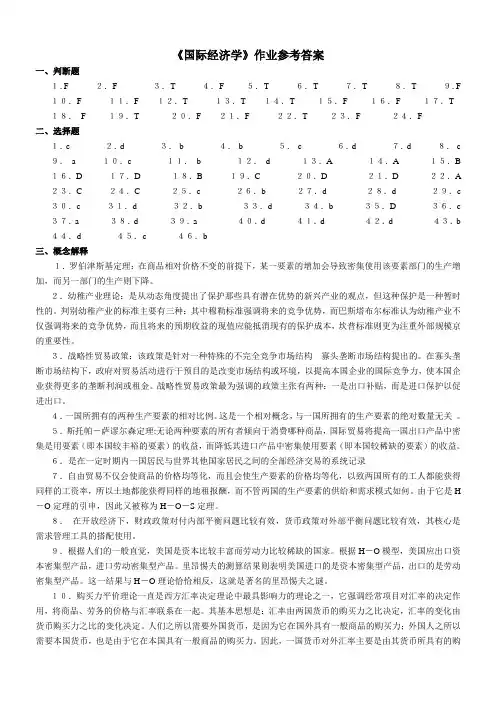
《国际经济学》作业参考答案一、判断题1.F2.F 3.T 4.F 5.T 6.T 7.T 8.T 9.F 10.F 11.F 12.T13.T 14.T 15.F 16.F 17.T 18.F 19.T 20.F 21.F 22.T23.F 24.F二、选择题1.c 2.d 3.b 4.b 5.c 6.d 7.d 8.c 9.a 10.c 11.b 12.d 13.A 14.A 15.B 16.D 17.D 18.B 19.C 20.D 21.D 22.A 23.C 24.C 25.c 26.b 27.d 28.d 29.c 30.c 31.d 32.b 33.d 34.b 35.D36.c 37.a 38.d 39.a 40.d 41.d 42.d 43.b 44.d 45.c 46.b三、概念解释1.罗伯津斯基定理:在商品相对价格不变的前提下,某一要素的增加会导致密集使用该要素部门的生产增加,而另一部门的生产则下降。
2.幼稚产业理论:是从动态角度提出了保护那些具有潜在优势的新兴产业的观点,但这种保护是一种暂时性的。
判别幼稚产业的标准主要有三种:其中穆勒标准强调将来的竞争优势,而巴斯塔布尔标准认为幼稚产业不仅强调将来的竞争优势,而且将来的预期收益的现值应能抵消现有的保护成本,坎普标准则更为注重外部规模京的重要性。
3.战略性贸易政策:该政策是针对一种特殊的不完全竞争市场结构---寡头垄断市场结构提出的。
在寡头垄断市场结构下,政府对贸易活动进行干预目的是改变市场结构或环境,以提高本国企业的国际竞争力,使本国企业获得更多的垄断利润或租金。
战略性贸易政策最为强调的政策主张有两种:一是出口补贴,而是进口保护以促进出口。
4.一国所拥有的两种生产要素的相对比例。
这是一个相对概念,与一国所拥有的生产要素的绝对数量无关。
5.斯托帕-萨谬尔森定理:无论两种要素的所有者倾向于消费哪种商品,国际贸易将提高一国出口产品中密集是用要素(即本国较丰裕的要素)的收益,而降低其进口产品中密集使用要素(即本国较稀缺的要素)的收益。
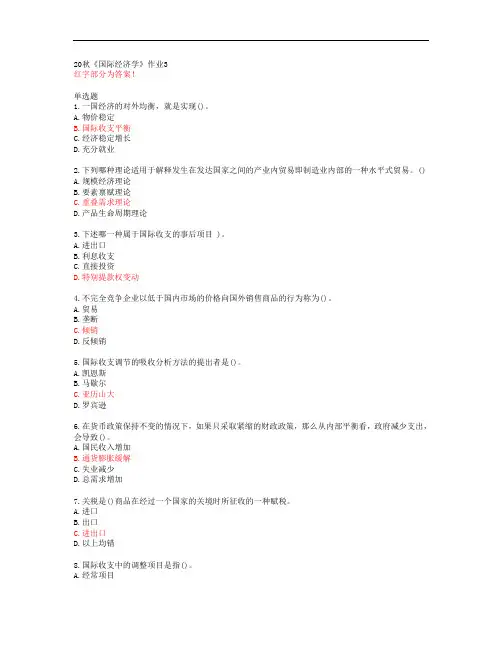
北语-21春《国际经济学》作业3
试卷总分:100 得分:100
一、单选题 (共 10 道试题,共 50 分)
1.一国经济的对外均衡,就是实现()。
A项.物价稳定
B项.国际收支平衡
C项.经济稳定增长
D项.充分就业
参考提示:本题为北语课程学习必答题,请认真复习课件,完成本题目
[正确答案]:B
2.下列哪种理论适用于解释发生在发达国家之间的产业内贸易即制造业内部的一种水平式贸易。
()
A项.规模经济理论
B项.要素禀赋理论
C项.重叠需求理论
D项.产品生命周期理论
参考提示:本题为北语课程学习必答题,请认真复习课件,完成本题目
[正确答案]:C
3.下述哪一种属于国际收支的事后项目( )。
A项.进出口
B项.利息收支
C项.直接投资
D项.特别提款权变动
参考提示:本题为北语课程学习必答题,请认真复习课件,完成本题目
[正确答案]:D
4.不完全竞争企业以低于国内市场的价格向国外销售商品的行为称为()。
A项.贸易
B项.垄断
C项.倾销
D项.反倾销
参考提示:本题为北语课程学习必答题,请认真复习课件,完成本题目
[正确答案]:C
5.国际收支调节的吸收分析方法的提出者是()。
A项.凯恩斯
B项.马歇尔
C项.亚历山大
D项.罗宾逊
参考提示:本题为北语课程学习必答题,请认真复习课件,完成本题目
[正确答案]:C。
《国际经济学》作业一(第1-5讲)一.选择:1、本国生产A、B、C、D 四种产品的单位劳动投入分别为1、2、4、15,外国生产这四种产品的单位劳动投入分别为12、18、24、30,根据李嘉图模型,本国在哪种产品上拥有最大比较优势?在哪种产品上拥有最大比较劣势?(1) D、A (2) C、B (3) A、D (4) B、C2.假定食品部门与制造业部门的特定要素分别为土地与资本,两部门共同要素为劳动力,如果食品价格下降8%,下列哪些叙述是正确的?(1) 工资率下降幅度小于8%(2) 食品部门产量下降、制造业部门产量上升(3) 资本所有者收入上升、土地所有者收入下降(4) 劳动力从食品部门流向制造业部门3.假定每单位A 产品的生产需要20 单位劳动与4 单位土地,每单位B 产品的生产需要1 单位劳动与4 单位土地,如果本国有1200 单位劳动与2000 单位土地,外国有400 单位劳动与500 单位土地,根据H-O 理论可推出(1) 本国出口A 产品、进口B 产品(2) 本国出口B 产品、进口A 产品(3) 外国出口A 产品、进口B 产品(4) 外国出口B 产品、进口A 产品4、赫克歇尔—俄林理论说明:(1)相对于其他资源,劳动力比较丰裕的国家并不具有比较优势。
(2)一个劳动力资源对非劳动力资源比率较高的国家,应当减少对国际贸易的参与(3)一个非劳动力资源相对丰裕的国家将不会从国际贸易中受益。
(4)国际市场力量将引导各国专业化于生产和出口大量使用其相对丰裕要素的商品。
5、如果—国在资本密集型产品的生产方面具有比较优势.而且,资本增长的速度快于其他投人品(如劳动力)的增长速度,那么,根据贸易理论,由此而导致增长模式为:(1)进口替代。
(2)资本密集型商品和其他贸易商品均衡增长。
(3)出口扩张(4)以上三者都不对。
6、以下产品中,哪一种最容易经历一个产品生命周期:(1)大米(2)电视机(3)原油(4)矿物7、根据比较优势原理的政策经验,一国从国际贸易中获益的条件是(1)制造大量出口顺差(2)以较低的机会成本进口商品而不是在国内生产(3)本国比贸易伙伴强大(4)本国相对于贸易伙伴具备绝对效率优势8、里昂惕夫悖论的经验研究结果是( )。
2021级南昌大学彭继增国际经济学练习题2021级《国际经济学》第三次作业1. 在古典贸易模型中,假设A国有120名劳动力,B国有50名劳动力,如果生产棉花的话,A国的人均产量是2吨,B国也是2吨;要是生产大米的话,A国的人均产量是10吨,B国则是16吨。
画出两国的生产可能性曲线并分析两国中哪一国拥有生产大米的绝对优势?哪一国拥有生产大米的比较优势?12. 下表列出了加拿大和中国生产1单位计算机和1单位小麦所需的劳动时间。
假定生产计算机和小麦都只用劳动,加拿大的总劳动为600小时,中国总劳动为800小时。
计算机小麦中国 100小时 4小时加拿大 60小时 3小时(1)计算不发生贸易时各国生产计算机和小麦的产量。
(2)哪个国家具有生产计算机的比较优势?哪个国家具有生产小麦的比较优势?(3)如果给定世界价格是1单位计算机交换22单位的小麦,加拿大参与贸易可以从每单位的进口中节省多少劳动时间?中国可以从每单位进口中节省多少劳动时间?如果给定世界价格是1单位计算机交换24单位的小麦,加拿大和中国分别可以从进口每单位的货物中节省多少劳动时间?(4)在自由贸易的情况下,各国应生产什么产品,数量是多少?整个世界的福利水平是提高还是降低了?试用图分析。
(以效用水平来衡量福利水平)23.假定中国总劳动为600小时,生产每单位钢铁Y需要4小时,而生产每单位大米X需要2小时,用图画出:(1)封闭经济中国的福利水平。
(2)假设开放后大米的相对价格为1,求开放后中国的福利总水平。
(3)开放的分工所得和交换所得。
34.假设在自给自足条件下,中国的汽车价格是20万/辆,需求量为100万辆。
中美两国进行汽车贸易,国际市场价格为15万/辆,中国自己生产60万辆,从美国进口60万辆。
中国的消费者是获得收益还是受到损失?生产者呢?总福利增加了吗?请用图和数值说明。
45.假设大米是劳动密集型产品,钢铁是资本密集型产品。
没有贸易发生以前,英国的大米/钢铁相对价格为4,菲律宾的大米/钢铁的相对价格为0.5。
东财《国际经济学》在线作三-0004试卷总分:100 得分:0一、单选题(共15 道试题,共60 分)1.提供曲线的移动意味着( )A.一国关税水平的变化B.一国贸易发展战略的变化C.一国贸易条件的变化D.一国贸易政策的变化正确答案:C2.能够从贸易创造效应中获得福利增加的是( )A.政府B.生产者C.出口商D.消费者正确答案:D3.在李嘉图的例子中,他假定了两国的交换比例,这种假定( )A.反映了两国的交换比例B.同现实情况基本相符C.只是一个简单假设,没有真正解决问题D.这个比例一旦确定就不会再发生变化正确答案:C4.认为外汇汇率是由国际收支状况决定的理论是( )A.购买力平价理论B.利率平价C.国际借贷说D.汇兑心理说正确答案:C5.劳动力发生自由流动之后,劳动力流入国的总收益将( )A.增加B.减少C.不变D.无法判断正确答案:A6.在下列观点上,吸收分析法和弹性分析法一致( )A.仅凭贬值无法改善国际收支逆差B.需要国内政策配合C.将贸易收支定义为国际收支D.提出了J曲线效应正确答案:C7.IMF《国际收支手册》判断居民和非居民的标准是()A.国籍B.地理位置C.民族D.经济利益中心正确答案:D8.国际金本位制属于()A.固定汇率制B.自由汇率制C.管理汇率制D.浮动汇率制E.美元汇率制正确答案:A9.如果一国发生了贫困化增长,说明该国的经济增长主要体现在( )A.进口部门B.出口部门C.进口竞争部门D.非贸易部门正确答案:B10.李斯特认为,保护幼稚工业的最高期限应该是( )A.10年B.20年C.30年D.50年正确答案:C11.可以平滑连续地对国际收支失衡进行修正,并保持外汇市场经常处于平衡状态的汇率制度是( )A.固定汇率制B.自由汇率制C.管理汇率制D.浮动汇率制正确答案:C12.如果在自由贸易条件下的各种进口要素成本与最终产品价格比例为0,则对最终产品生产者的有效保护率( )A.等于名义保护率B.大于名义保护率C.小于名义保护率D.无法判断正确答案:A13.根据孟代尔-弗莱明模型,在浮动汇率制下,财政政策()A.完全失效B.完全有效C.同货币政策作用一致D.无法判断正确答案:A14.布雷顿森林体系属于( )A.固定汇率制B.自由汇率制C.管理汇率制D.浮动汇率制正确答案:A15.下列理论中,比较重视长期均衡条件分析的理论是( )A.弹性分析法B.货币分析法C.吸收分析法D.资产组合分析法正确答案:B二、多选题(共10 道试题,共40 分)1.弗农将产品生命周期分为()A.新产品阶段B.成长阶段C.成熟阶段D.标准化阶段E.衰退阶段正确答案:ABCDE2.进口替代战略的优点主要有( )A.有利于摆脱发达国家的控制B.有利于实现工业化C.有利于平衡国际收支D.有利于扩大就业E.有利于提高国际竞争力正确答案:ABCD3.贸易自由化同资本主义自由竞争时期出现的自由贸易有所不同,主要表现在( )A.自由与保护相结合B.实际上是管理贸易C.保护重点由限制进口转为鼓励出口D.是有选择的自由化E.是在国家垄断资本主义加强的条件下发展起来的正确答案:ADE4.分析国际收支平衡表的方法有()A.动态分析B.静态分析C.比较动态分析D.多维分析E.比较分析正确答案:ABE5.狭义外汇必须具备的条件是( )A.只在外国流通B.必须以外币表示C.可以用做记账D.必须能进行国际偿付E.必须能兑换为其他支付手段正确答案:BDE6.对外贸易政策包括()A.对外贸易关税政策B.对外贸易配额政策C.对外贸易总政策D.对外贸易国别政策E.对外贸易商品政策正确答案:CDE7.按照一体化的程度高低,国际经济一体化一般有下列形式( )A.优惠贸易安排B.自由贸易区C.关税同盟D.共同市场E.经济联盟正确答案:ABCDE8.国际贸易对要素收入的影响为( )A.使出口部门特定要素的所有者受益B.使与进口竞争部门特定要素的所有者受损C.对流动要素的影响不确定D.使出口部门特定要素的所有者受损E.使与进口竞争部门特定要素的所有者受益正确答案:ABC9.按照政府是否干预,浮动汇率制可以分为()A.单独浮动B.清洁浮动C.管理浮动D.钉住浮动E.联合浮动正确答案:BC10.根据经济增长过程中一国出口商品生产与进口商品生产之间的相对速度,可以将经济增长划分为()A.顺贸易型经济增长B.逆贸易型经济增长C.中性经济增长D.劳动节约型经济增长E.资本节约型经济增长正确答案:ABC。
奥鹏14秋东北财经大学《国际经济学》在线作业三答案1.赫-俄模型仍然沿用了李嘉图比较利益理论的2*2*1模式,这种说法是()A.正确的B.错误的C.无法判断答案:B满分:4分得分:42.国际货币基金组织的国际收支概念是()A.仅指贸易收支B.仅指外汇收支C.狭义的国际收支D.广义的国际收支答案:D满分:4分得分:43.IMF《国际收支手册》判断居民和非居民的标准是()A.国籍B.地理位置C.民族D.经济利益中心答案:D满分:4分得分:44.根据相互需求原理,决定两国产品交换实际比例的关键因素是()A.两国的要素禀赋B.两国的比较优势C.两国的相对需求强度D.两国的技术水平答案:C满分:4分得分:45.根据H-O-S定理,国际贸易对相对要素价格和绝对要素价格的影响是()A.都无影响B.都均衡化C.绝对价格均等,相对价格不确定D.相对要素价格均等,绝对价格不确定E.上述说法都不正确答案:B满分:4分得分:46.根据货币主义汇率理论,在其他条件不变的情况下,一国的国民收入增长快于其他国家会导致该国货币汇率()A.上升B.下跌C.不变D.难以判断答案:A满分:4分得分:47.根据罗布津斯基定理,一种要素的增加将引起密集使用该要素的产品产量以更大的比例增长,同时其他产品的产量将()A.增加B.减少C.不变D.无法判断答案:B满分:4分得分:48.根据孟代尔-弗莱明模型,在固定汇率制下,货币政策()A.完全失效B.完全有效C.同财政政策作用一致D.无法判断答案:A满分:4分得分:49.根据孟代尔-弗莱明模型,在浮动汇率制下,财政政策()A.完全失效B.完全有效C.同货币政策作用一致D.无法判断答案:A满分:4分得分:410.根据政策配合说,被分派去管理外部均衡的是()A.汇率政策B.货币政策C.外汇政策D.财政政策答案:B满分:4分得分:411.产品生命周期理论运用的是()A.静态分析B.比较静态分析C.动态分析D.上述说法都不正确答案:C满分:4分得分:412.根据政策配合说,比较合理的政策组合是()A.财政政策对内,货币政策对外B.财政政策对外,货币政策对内C.汇率政策对内,支出调整政策对外D.汇率政策对外,支出调整政策对内答案:A满分:4分得分:413.根据乘数原理,进出口数量的变化给国民收入带来的影响比进出口本身的数量要()A.一致B.大C.小D.无关答案:B满分:4分得分:414.管理浮动又叫()A.清洁浮动B.肮脏浮动C.钉住浮动D.单独浮动答案:B满分:4分得分:415.关税同盟理论的提出者是()A.李斯特B.弗农C.林德D.瓦伊纳答案:D满分:4分得分:41.进口替代战略的优点主要有()A.有利于摆脱发达国家的控制B.有利于实现工业化C.有利于平衡国际收支D.有利于扩大就业E.有利于提高国际竞争力答案:ABCD满分:4分得分:42.货币分析理论的缺陷在于()A.仅从货币市场来分析国际收支B.将贸易收支视为国际收支C.货币需求量不是收入的稳定函数D.忽略了实际利率的影响E.忽略了国内政策的作用答案:ACD满分:4分得分:43.金本位制经过了以下阶段()A.金平价本位制B.金币本位制C.金块本位制D.金汇兑本位制E.黄金非货币本位制答案:BCD满分:4分得分:44.比较优势可以分解成()A.来自贸易的利益B.来自保护的利益C.来自分工的利益D.来自管理的利益E.来自征收关税的利益答案:AC满分:4分得分:45.导致国际收支失衡的主要原因有()A.政治原因B.经济周期C.国民收入变化D.货币价值变动E.经济结构答案:BCDE满分:4分得分:46.金融帐户包括()A.直接投资B.证券投资C.间接投资D.其他投资E.储备资产答案:ABDE满分:4分得分:47.关税所产生的经济效应主要包括()A.国内效应B.进口效应C.出口效应D.价格效应E.贸易条件效应答案:ADE满分:4分得分:48.赫-俄模型假定()A.两国的技术水平相同B.要素在两国间完全不能流动C.两种产品的生产都具有规模报酬不变的特点D.没有运输成本E.两国的资源都得到了充分利用答案:ABCDE满分:4分得分:49.东道国政府对跨国公司的限制性规定主要包括()A.减免原材料关税B.规定外资股权比例C.限制对外资开放的经营领域D.要求外资企业实现外汇平衡E.限制外资企业利润的汇回答案:BCDE满分:4分得分:410.比较优势理论假定()A.所有劳动都是同质的B.两国实行自由贸易C.规模收益不变D.国际经济是静态的E.只有一种生产要素答案:ABCDE满分:4分得分:4。
(0403)《国际经济学》网上作业题及答案1:第一次作业2:第二次作业3:第三次作业4:第四次作业5:第五次作业1:[论述题]一、名词解释1.经济相互依存性2.经济活动的全球化3.无差异曲线4.边际替代率(marginal rate of substitution, MRS)5.俄林─赫克歇尔的资源禀赋理论二、简述题1.简述亚当.斯密绝对优势论的基本内容2.简述大卫.李嘉图比较优势论的基本内容3.简述成本差异理论对国际贸易模式决定的缺陷三、论述题1. 论述赞成和反对开放贸易体制的主要观点2. 论述经济全球化的利与弊的主要观点参考答案:1:[论述题]一、名词解释6. 里昂惕夫之谜7.规模经济(economics of scale)8.动态比较优势(dynamic comparative advantage)。
9.产业政策(industrial policy)10.关税(tariff)4. 简述关税如何加重出口商的负担?5. 简述幼稚产业理论的主要内容6. 简述战略贸易理论的主要内容三、论述题3.论述小国征收关税的福利效应4. 论述大国征收关税的福利效应参考答案:1:[论述题]一、名词解释11.有效关税保护率(effective tariff rate)12.消费者剩余13.生产者剩余14.进口配额(import quota)15.关税税率配额(tariff-rate quota)二、简述题7. 简述跨国企业的主要经营方式8. 简述对外直接投资的主要原因9. 简述外汇交易的主要类型三、论述题5. 论述补贴的贸易和福利效应6. 论述环境贸易壁垒的基本特点参考答案:1:[论述题]一、名词解释16.有序销售协定(orderly marketing agreement, OMA)17.国内含量条件(domestic content requirements) 18.补贴(subsidies)19.倾销(dumping)20. 政府采购制度10. 简述国际收入差异对汇率的影响11. 简述吸收分析法对汇率的调整12. 简述货币分析法对汇率的调整三、论述题7. 经济制裁效应及影响经济制裁成功的因素8. 论述发展中国家的贸易特征及存在的贸易问题参考答案:1:[论述题]一、名词解释 社会管制22.普惠制(♑♏⏹♏❑♋●♓♏♎ ♦⍓♦♦♏❍ ☐♐ ☐❑♏♐♏❑♏⏹♍♏♦ ☝ ).国际经济政策(♓⏹♦♏❑⏹♋♦♓☐⏹♋● ♏♍☐⏹☐❍♓♍ ☐☐●♓♍⍓) 24.经济政策的内部均衡(internal balance). 欧洲货币市场二、简述题13. 简述赞成和反对浮动汇率制的理由14. 简述可调整钉住汇率制的主要特征15. 简述爬行钉住汇率制的含义及运用三、论述题9.论述发展中国家实行进口替代战略的优缺点10. 论述区域贸易协定的效应参考答案:。
1. 试述赞成和反对开放贸易体制下的观点主要有哪些?答:(1)赞成的主要观点:开放贸易体制有助于产出增加,生活水平提高。
开放贸易可以用所得收入去购买一些他们只能以高成本生产的产品,用有限的资源生产出更多的产品,达到较高的生活水平。
开放贸易体制有助于消除国内通货膨胀压力。
通货膨胀━本币的外币价值升值━进口商品的本币价格变得便宜━较低通货膨胀率;开放贸易体制有助于减少或消除私人投资被挤出情况;开放贸易体制有助于利用国外市场来平衡国内经济。
当国内经济衰退时,世界其他市场可以倾泻国内剩余产品;在短缺时,世界其它市场商品用来满足国内消费;开放贸易体制使得国内经济衰退的幅度小,时间短。
因为推动经济变革的最有力的力量是经济相互依存性增强的经济活动全球化。
(2)反对的主要观点:贸易是零和博弈,即一方收益,另一方有损;进口会减少就业机会,出口促进经济增长和就业。
(忽略了进出口间的关系);关税、配额和其他限制进口的措施会保护工作岗位。
(进口减少不会孤立的发生);外来竞争行业的工资将会下降;较高的开放度影响财政政策(税收和政府开支)。
如国内居民将更大比例的收入用于购买进口商品,增加国内居民收入和支出的扩展性财政政策,通过进口的增加会更快地扩散到海外,从而削弱财政政策对国内经济的影响。
2.试述发展中国家实施出口导向贸易政策的优缺点答:出口导向型经济发展战略的优点是:(1)对外贸易增长较快,出口商品中制成品所占比重迅速上升;(2)增加了资金积累,使国民经济出现较快的增长;(3)制造业在国内生产总值中所占比重显著上升,一些国家已接近发达国家的水平;(4)工业化进程快于其余发展中国家和地区。
出口导向型经济发展战略的缺点是:(1)容易受到世界市场波动的冲击;(2)建立的工业自主性差;(3)债务负担加重。
3.进口替代的优缺点答:进口替代是指发展中国家本来靠进口的工业制成品,不依靠进口,而依靠本国自己的力量制造该种商品以代替进口。
这种贸易形式是以"自力更生”为指导思想的,通过广泛运用贸易壁垒,保护国内产业免受进口竞争,贸易和生产的目的是扶植国内市场,而不是出口市场。
进口替代的极端化会产生完全自给自足的经济。
进口替代的理论解释:幼稚产业理论,即保护新兴产业,让它们成长壮大,直到能够与发达国家的产业进行竞争。
进口替代的优点:有的发展中国家经济学者认为,其优点能在国家的保护下,利用本国资源从事工业制成品的生产。
也有一些学者认为,发展"进口替代”,如果掌握得当,给发展中国家也会带来一些好处。
比如,为发展工业创造必备条件,培养技术和管理人才,促进国内工业发展的多样化,实现生产资料和生活资料某种程度的自给自足,摆脱对外国商品进口的依赖,减少外汇支出,积累一些资金,引进外国技术和设备,这都有利于本国出口工业的发展。
具体表现在:(1)由于国内已经存在市场,建立本国产业替代进口品的风险较低;(2)对发展中国家来说,保护国内的制造商免受国外竞争,要比迫使工业化国家减少对发展中国家出口产品的贸易更加容易;(3)为了避免发展中国家的进口关税壁垒,外国厂商愿意将工厂建在该国国内,这就为当地劳动者提供了就业机会。
进口替代的不足:实行"进口替代”也有很大不足,主要是过于强调保护国内市场,实际保护了国内落后的工业企业,不利于促进国内工业生产技术和管理水平的提高,不容易提高本国产品的竞争能力。
(1)国内产业因贸易保护而避免国际竞争,会没有动力提高效率;(2)大多数发展中国家的国内市场规模较小,制造商难以实现规模经济,造成单位成本偏高;(3)如果没有贸易保护,受保护产业使用的资源原本会流到其他产业。
因此,对进口竞争产业的保护对其他产业构成了歧视,包括潜在的出口产业。
4.试述最有货币区理论的主要内容和结论答:一、最优货币区理论内容不同国家使用同一种货币存在很多收益,包括价格更为一致、降低交易成本、提高投资的确定性和增强竞争等。
同时,独立的中央银行制定的单一货币政策还可以促进价格稳定。
另一方面,单一货币政策具有成本,尤其是当利率变化以不同方式影响不同的经济体时(因为加入货币联盟,意味着各成员国放弃了制定独立的货币政策和自行改变汇率的权利。
由此共同货币政策的毛收益必须与放弃这两种政策工具产生的损失相比较。
一旦一个国家或地区出现“不对称冲击”,失去这两种工具的后果就更为严重,因为该经济体将再也不能通过扩张性货币政策或调节货币发行量来对外部的变化作出反应。
)。
最优货币区理论还分析了化解“不对称冲击”的各种办法,主要有三种:(1)劳动力的流动性。
受影响国家的工人必须能够也愿意自由流动到其它国家。
(2)价格和工资的灵活性。
该国必须能够根据外部的变化相应调整价格和工资。
(3)要有某种自动机制,可以把财政资源转移到受影响的国家。
二、最优货币区理论的结论:一个货币区要想拥有最大的成功算数,不对称冲击应当很少,即包括的国家应当具有相似的经济周期和经济结构,共同货币政策对所有成员国的影响方式也必须相同。
而且,劳动力的跨国流动不应存在法律、文化或语言上的障碍,工资应当具有灵活性,应当有某种发挥稳定作用的转移机制。
5.试述国际贸易理论与跨国企业理论的相同点与不同点有哪些?答:国际贸易理论与跨国企业理论有一致的地方,同时也有不同的地方。
(一) 国际贸易理论与跨国企业相一致1、比较优势原理可以说明企业从事国际业务的原因。
从企业管理者的角度来看,看见其他国家存在有他们利用的优势,包括投入要素、新技术、新产品和管理技巧。
在海外设立子公司会极大地增加利润。
2、从贸易理论来看,跨国企业分析与比较优势理论的预测相一致。
两种方法都认为,一种商品将在成本低的国家生产。
3、国际贸易理论认为,跨国企业为了自己的利益而进行对外直接投资时,东道国和来源国的总福利都会提高,资源就从生产率低的用途转移到生产率高的用途,实现在世界范围内的有效配置。
(二) 国际贸易理论与跨国企业不一致1、跨国企业侧重于投入要素的国际流动;国际贸易的基础是商品在国家间的流动。
2、跨国企业使国际贸易内部化。
传统贸易理论指出,产品在国际市场上按照竞争的价格在相互独立的组织间进行交换;而跨国企业一般是纵向一体化的公司,其子公司既生产中间产品,也生产制成品,产品从一个子公司转移到另一个子公司,销售成为内部的事情,确定商品价值的是生产要素,不是竞争性的定价机制。
6.试述环境贸易壁垒的主要内容和形式有哪些?答:环境贸易壁垒也称绿色贸易壁垒,指一些国家和国际组织通过制定环境标准和法规,对可能形成生态破坏和环境污染的一些国际贸易活动加以管制,从而对自由贸易形成障碍的一种非关税贸易措施。
环境贸易壁垒通常分为两类:一类是政府引导型的绿色壁垒,它以保护自然资源、生态环境和人类健康为名,通过制定一系列的环保标准对来自其他国家和地区的产品设置关卡,限制其进口;另一类是非政府引导型的绿色壁垒,即是一些国家环境保护意识较强的生产商或消费者,对其他国家不符合其环境标准的产品和服务的歧视。
目前,绿色壁垒的表现形式多种多样,涉及法律、法规、标准、程序等各个方面,基本形成了一个比较完备的体系,主要包括如下内容:(1) 环境标准和法规。
指一些国家凭借其经济和技术条件的垄断优势,通过立法手段,对环境中污染物水平及其排放源的限量阈值制定苛刻的强制性技术标准,通过行使境外管辖权来限制外国商品的进入;国际上为保护环境而制定的环境公约中的有关条款也常常形成对一些国际贸易活动的限制。
如欧盟近年全面启动ISO14000环境管理体系认证机制,要求进入其成员国的产品达到其规定的环境技术标准等。
(2) 环境标志制度。
环境标志是一种经权威机构认定的图形,它表明该产品不但质量符合环境标准,而且其生产、使用、消费、回收的过程也符合环保要求。
环境标志既是全球绿色消费浪潮的产物,又反过来引导绿色消费。
它在西方国家消费人群中影响很大,调查表明,84%的荷兰人、89%的美国人、90%的德国人在购物时会考虑消费品是否具有绿色标志,有人甚至愿意多花10%的费用来购买绿色产品。
发展中国家由于自身条件的限制,要开展环境标志的国际认证存在着较大的困难,因而其出口的不少商品往往在国际市场上处于很不平等的竞争地位。
(3) 成本内在化要求与绿色补贴限制。
成本内在化要求生产者将环境退化及其治理的费用计入产品成本,而发展中国家由于环境标准较低,暂时无力承担治理污染的所有费用,因而被认为给予了其出口商品以隐含的补贴。
另一方面,发展中国家的政府有时为了扶持民族工业的成长,对环保产业或外贸企业给予一定的环境补贴。
而西方国家认为无论是隐含或公开的补贴均违反了世界组织的有关原则,需要实施贸易制裁。
美国就曾以环保补贴为由,对来自巴西的人造胶鞋和来自加拿大的速冻猪肉提出过反补贴诉讼。
(4) 包装的环保要求。
包装对环境的负面影响主要是由于包装材料及其所形成的废弃物和包装容器结构而引起,如PVC塑料,难以自然降解,焚烧处理时又污染环境。
为此,许多国家颁布了不少有关包装的法律法规。
如英国制定了包装材料重新使用的计划,要求2000年前使包装废弃物的50%-75%重新使用。
由于这些规定是按照西方国家国内资源禀赋、消费偏好等因素确定的,发展中国家或是难以适应,或是增加改装成本,从而起到了贸易限制的实际效果。
7. 试述可调整的钉住汇率制度的主要特征及实施存在的问题答:(一) 可调整的钉住汇率制的主要特征:各国货币相互联系,为商业和金融交易提供稳定的汇率。
当国际收支失衡时,各成员国原则上同意尽可能长时间地保留现有平价。
它们首先运用财政政策和货币政策矫正收支失衡。
但是,如果消除收支的持续失衡意味着要使国内经济遭受严重的破坏,如通货膨胀或失业,那么,成员国可以采用改变钉住汇率的方式,消除这种根本性失衡。
钉住汇率变动10%以内,无需经由国际货币基金组织批准。
超过10%则需征得货币基金组织的同意。
(二) 可调整的钉住汇率制实施的问题:在布雷顿森林体系中,物价和收入水平的调整经常与维持国内经济稳定的目标相冲突。
各国往往不愿意本币贬值,因为国内政策不仅失败,也会降低本国的国际声誉。
相反,本币升值是出口商所不能接受的,因为这会损害到他们的生计。
只有在迫不得已的情况下,才会重新确定钉住汇率,通常需要大规模的进行调整。
8.试述小国征收关税所产生的效应答:对贸易小国来讲,由于其进出口数量小,它是国际价格接受者而不会成为国际价格的制定者。
即便在征收关税的情况下,虽然进口商品国内市场价格的上升幅度等于关税税率,但其变动不足以影响国际市场的价格。
经济会出现无效率,减少国家福利。